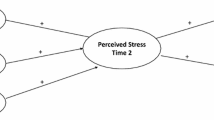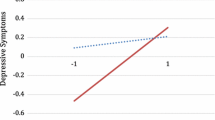Abstract
Hispanic youth are at risk for experiencing depressive symptoms and smoking cigarettes, and risk for depressive symptoms and cigarette use increase as Hispanic youth acculturate to U.S. culture. The mechanism by which acculturation leads to symptoms of depression and cigarette smoking is not well understood. The present study examined whether perceived discrimination explained the associations of acculturation with depressive symptoms and cigarette smoking among 1,124 Hispanic youth (54% female). Youth in Southern California completed surveys in 9th–11th grade. Separate analyses by gender showed that perceived discrimination explained the relationship between acculturation and depressive symptoms for girls only. There was also evidence that discrimination explained the relationship between acculturation and cigarette smoking among girls, but the effect was only marginally significant. Acculturation was associated with depressive symptoms and smoking among girls only. Perceived discrimination predicted depressive symptoms in both genders, and discrimination was positively associated with cigarette smoking for girls but not boys. These results support the notion that, although Hispanic boys and girls experience acculturation and discrimination, their mental health and smoking behaviors are differentially affected by these experiences. Moreover, the results indicate that acculturation, gender, and discrimination are important factors to consider when addressing Hispanic youth’s mental health and substance use behaviors.






Similar content being viewed by others
References
Alegria, M., Canino, G., Shrout, P. E., Woo, M., Duan, N., Vila, D., et al. (2008). Prevalence of mental illness in immigrant and non-immigrant U.S. Latino groups. The American Journal of Psychiatry, 165(3), 359–369.
Alegria, M., Shrout, P. E., Woo, M., Guarnaccia, P., Sribney, W., Vila, D., et al. (2007). Understanding differences in past year psychiatric disorders for Latinos living in the US. Social Science and Medicine, 65(2), 214–230.
Alegria, M., Vila, D., Woo, M., Canino, G., Takeuchi, D., Vera, M., et al. (2004). Cultural relevance and equivalence in the NLAAS instrument: Integrating etic and emic in the development of cross-cultural measures for a psychiatric epidemiology and services study of Latinos. International Journal of Methods in Psychiatric Research, 13(4), 270–288.
Andrade, L., Caraveo-Anduaga, J., Berglund, P., Bijl, R. V., De Graaf, R., Vollebergh, W., et al. (2003). The epidemiology of major depressive episodes: Results from the international consortium of psychiatric epidemiology (ICPE) surveys. International Journal of Methods in Psychiatric Research, 12(1), 3–21.
Baron, R. M., & Kenny, D. A. (1986). The moderator–mediator variable distinction in social psychological research: Conceptual, strategic, and statistical considerations. Journal of Personality and Social Psychology, 51(6), 1173–1182.
Berry, J. W., Trimble, J. E., & Olmedo, E. L. (1986). Assessment of acculturation. In J. W. Berry (Ed.), Field methods in cross-cultural research (pp. 291–324). Thousand Oaks, CA, USA: Sage Publications, Inc.
Bethel, J. W., & Schenker, M. B. (2005). Acculturation and smoking patterns among Hispanics: A review. American Journal of Preventive Medicine, 29(2), 143–148.
Breslau, N., Peterson, E. L., Schultz, L. R., Chilcoat, H. D., & Andreski, P. (1998). Major depression and stages of smoking: A longitudinal investigation. Archives of General Psychiatry, 55(2), 161–166.
Cabassa, L. J. (2003). Measuring acculturation: Where we are and where we need to go. Hispanic Journal of Behavioral Sciences, 25(2), 127–146.
Center for Disease Control, Prevention (CDC). (2009). Smoking-attributable mortality, years of potential life lost, and productivity losses—United States, 2000–4. MMWR, 57, 1226–1228.
Cook, B., Alegría, M., Lin, J. Y., & Guo, J. (2009). Pathways and correlates connecting Latinos’ mental health with exposure to the United States. American Journal of Public Health, 99(12), 2247–2254.
Crenshaw, K. (1989). Demarginalizing the intersection of race and sex: A black feminist critique of antidiscrimination doctrine, feminist theory and antiracist politics’. The University of Chicago Legal Forum, 139.
Cuéllar, I., Arnold, B., & Maldonado, R. (1995). Acculturation rating scale for Mexican Americans-II: A revision of the original ARSMA scale. Hispanic Journal of Behavioral Sciences, 17(3), 275–304.
De la Rosa, M. R. (2002). Acculturation and Latino adolescents’ substance use: A research agenda for the future. Substance Use and Misuse, 37(4), 429–456.
Emslie, G. J., Weinberg, W. A., Rush, A. J., & Adams, R. M. (1990). Depressive symptoms by self-report in adolescence: Phase I of the development of a questionnaire by self-report. Journal of Child Neurology, 5(2), 114–121.
Epstein, J. A., Botvin, G. J., & Diaz, T. (1998). Linguistic acculturation and gender effects on smoking among Hispanic youth. Preventive Medicine: An International Journal Devoted to Practice and Theory, 27(4), 583–589.
Espin, O. M. (1987). Psychological impact of migration on Latinas: Implications for psychotherapeutic practice. Psychology of Women Quarterly, 11(4), 489–503.
Gil, R. M., & Vazquez, C. I. (1996). The Maria paradox. How Latinas can merge old world traditions with new world esteem. New York: Putnam.
Gonzales, N. A., Deardorff, J., Formoso, D., Barr, A., & Barrera, M., Jr. (2006). Family mediators of the relation between acculturation and adolescent mental health. Family Relations, 55(3), 318–330.
Guyll, M., Matthews, K. A., & Bromberger, J. T. (2001). Discrimination and unfair treatment: Relationship to cardiovascular reactivity among African American and european american women. Health Psychology: Official Journal of the Division of Health Psychology American Psychological Association, 20(5), 315–325.
Hammen, C. (2005). Stress and depression. Annual Review of Clinical Psychology, 1(1), 293–319.
Johnston, L. D., O’Malley, P. M., Bachman, J. G., & Schulenberg, J. E. (2009). Monitoring the future national results on adolescent drug use: Overview of key findings, 2008 (NIH publication no. 09-7401). Bethesda, MD: National Institute on Drug Abuse.
Kam, J. A., Cleveland, M. J., & Hecht, M. L. (2010). Applying general strain theory to examine perceived discrimination’s indirect relation to Mexican-heritage youth’s alcohol, cigarette, and marijuana use. Prevention Science, 11, 397–410.
Kendler, K. S., Neale, M. C., MacLean, C. J., Heath, A. C., Eaves, L. J., & Kessler, R. C. (1993). Smoking and major depression. A causal analysis. Archives of General Psychiatry, 50(1), 36–43.
Lara, M., Gamboa, C., Kahramanian, M. I., Morales, L. S., & Bautista, D. E. H. (2005). Acculturation and Latino health in the United States: A review of the literature and its sociopolitical context. Annual Review of Public Health, 26, 367–397.
Oetting, G. R., & Beauvais, F. (1990). Orthogonal cultural identification theory: The cultural identification of minority adolescents. International Journal of the Addictions, 25(5-), 655–685.
Ong, A. D., Fuller-Rowell, T., & Burrow, A. L. (2009). Racial discrimination and the stress process. Journal of Personality and Social Psychology, 96(6), 1259–1271.
Pérez, D. J., Fortuna, L., & Alegría, M. (2008). Prevalence and correlates of everyday discrimination among U.S. Latinos. Journal of Community Psychology, 36(4), 421–433.
Pessar, P. R. (1999). Engendering migration studies. American Behavioral Scientist, 42(4), 577.
Pomerleau, O. F., & Pomerleau, C. S. (1991). Research on stress and smoking: Progress and problems. British Journal of Addiction, 86(5), 599–603.
Pratt, L. A., & Brody, D. J. (2010). Depression and smoking in the U.S. household population aged 20 and over, 2005–2008. U.S. Department of Health and Human Services (CDC), HCHS Data Brief, No. 4.
Prokhorov, A. V., Winickoff, J. P., Ahluwalia, J. S., Ossip-Klein, D., Tanski, S., Lando, H. A., et al. (2006). Youth tobacco use: A global perspective for child health care clinicians. Pediatrics, 118(3), e890.
Quattrocki, E., Baird, A., & Yurgelun-Todd, D. (2000). Biological aspects of the link between smoking and depression. Harvard Review of Psychiatry, 8(3), 99–110.
Radloff, L. S. (1977). The CES-D scale: A self-report depression scale for research in the general population. Applied Psychological Measurement, 1(3), 385–401.
Romero, A. J., & Roberts, R. E. (2003). The impact of multiple dimensions of ethnic identity on discrimination and adolescents Self-Estees. Journal of Applied Social Psychology, 33(11), 2288.
Sarmiento, I. A., & Cardemil, E. V. (2009). Family functioning and depression in low income Latino couples. Journal of Marital and Family Therapy, 35(4), 432–445.
Schwartz, S. J., Unger, J. B., Zamboanga, B. L., & Szapocznik, J. (2010). Rethinking the concept of acculturation: Implications for theory and research. American Psychologist, 65(4), 237–251.
Sias, J. J., Urquidi, U. J., Bristow, Z. M., Rodriguez, J. C., & Ortiz, M. (2008). Evaluation of smoking cessation behaviors and interventions among Latino smokers at low-income clinics in a US-Mexico border county. Addictive Behaviors, 33(2), 373–380.
Smart, J. F., & Smart, D. W. (1995). Acculturative stress of hispanics: Loss and challenge. Journal of Counseling & Development, 73(4), 390–396.
SPSS for Windows. (2009). PASW Statistics Release 18.0.0 (July 13). SPSS Inc., Chicago.
Sullivan, S., Schwartz, S. J., Prado, G., Huang, S., Pantin, H., & Szapocznik, J. (2007). A bidimensional model of acculturation for examining differences in family functioning and behavior problems in Hispanic immigrant adolescents. The Journal of Early Adolescence, 27(4), 405–430.
Tyas, S. L., & Pederson, L. L. (1998). Psychosocial factors related to adolescent smoking: A critical review of the literature. Tobacco Control, 7(4), 409.
Umaña-Taylor, A. J., & Fine, M. A. (2001). Methodological implications of grouping Latino adolescents into one collective ethnic group. Hispanic Journal of Behavioral Sciences, 23(4), 347–362.
Unger, J. B., Ritt-Olson, A., Soto, D. W., & Baezconde-Garbanati, L. (2009a). Parent–child acculturation discrepancies as a risk factor for substance use among Hispanic adolescents in southern California. Journal of Immigrant and Minority Health, 11(3), 149–157.
Unger, J. B., Ritt-Olson, A., Wagner, K. D., Soto, D. W., & Baezconde-Garbanati, L. (2009b). Parent–child acculturation patterns and substance use among Hispanic adolescents: A longitudinal analysis. The Journal of Primary Prevention, 30(3–4), 293–313.
U.S. Census Bureau. (2006). Nation’s populations one-third minority. Retrieved September 02, 2010, from http://www.census.gov/newsroom/releases/archives/population/cb06-72.html.
Valenzuela, A., Jr. (1999). Gender roles and settlement activities among children and their immigrant families. American Behavioral Scientist, 42(4), 720–742.
Vega, W. A., & Sribney, W. M. (2008). Latino population demographics, risk factors, and depression: A case study of the Mexican-American prevalence and services survey. In T. P. Gullotta (Ed.), Depression in Latinos: Assessment, treatment, and prevention (pp. 29–52). New York, NY, USA: Springer Science+Business Media.
Weersing, R. V., & Brent, D. A. (2006). Cognitive behavioral therapy for depression in youth. Child and Adolescent Psychiatric Clinics of North America, 15, 939–957.
Wiehe, S. E., Aalsma, M. C., Liu, G. C., & Fortenberry, J. D. (2010). Gender differences in the association between perceived discrimination and adolescent smoking. American Journal of Public Health, 100(3), 510–516.
Acknowledgments
This work was supported by the National Institute on Drug Abuse (Grant # DA016310), and the University of Michigan Substance Abuse Research Center/NIDA Pre-doctoral Training Fellowship (Grant # T32DA007267).
Author information
Authors and Affiliations
Corresponding author
Rights and permissions
About this article
Cite this article
Lorenzo-Blanco, E.I., Unger, J.B., Ritt-Olson, A. et al. Acculturation, Gender, Depression, and Cigarette Smoking Among U.S. Hispanic Youth: The Mediating Role of Perceived Discrimination. J Youth Adolescence 40, 1519–1533 (2011). https://doi.org/10.1007/s10964-011-9633-y
Received:
Accepted:
Published:
Issue Date:
DOI: https://doi.org/10.1007/s10964-011-9633-y




